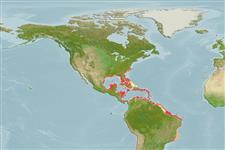Common names from other countries
Environment: milieu / climate zone / depth range / distribution range
Ecologia
marinhas associadas(os) a recifes; intervalo de profundidade 0 - 30 m (Ref. 9626). Tropical; 45°N - 8°N, 99°W - 58°W (Ref. 55370)
Western Atlantic: Florida, USA to Brazil. Larvae are sometimes swept northward which accounts for the sighting of juvenile specimens as far north as Massachusetts, USA during summer months. One record (one specimen, 3 cm) from Musquodoboit Harbor, Nova Scotia, Canada.
Length at first maturity / Tamanho / Peso / Idade
Maturity: Lm 13.9 range ? - ? cm
Max length : 20.0 cm TL macho/indeterminado; (Ref. 7251)
Espinhos dorsais (total): 12 - 14; Raios dorsais moles (total): 18-21; Espinhos anais 3; Raios anais moles: 15 - 17. Body is white with a black bar running across the head through the eye. In juveniles, a second black bar runs from the base of the soft portion of the dorsal fin to the base of the anal fin. The dorsal, caudal and anal fins are either yellow or transparent (Ref. 4855). A narrow yellow bar from gill opening to pectoral base (Ref. 13442).
Inhabit shallow, coral reefs with clear water (Ref. 9626). Develop dusky bands at night. Generally common (Ref. 9710). Oviparous (Ref. 205). Form pairs during breeding (Ref. 205).
Life cycle and mating behavior
Maturidade | Reprodução | Desova | Ovos | Fecundidade | Larvas
Form pairs during breeding (Ref. 205).
Randall, J.E., 1996. Caribbean reef fishes. Third Edition - revised and enlarged. T.F.H. Publications, Inc. Ltd., Hong Kong. 3nd ed. 368 p. (Ref. 13442)
Categoria na Lista Vermelha da IUCN (Ref. 130435)
CITES (Ref. 128078)
Not Evaluated
Ameaça para o homem
Harmless
Utilização humana
Aquário: Espécies comerciais
Ferramentas
Relatórios especiais
Descarregue XML
Fontes da internet
Estimates based on models
Preferred temperature (Ref.
115969): 23.9 - 28.2, mean 27.2 (based on 612 cells).
Phylogenetic diversity index (Ref.
82804): PD
50 = 0.5000 [Uniqueness, from 0.5 = low to 2.0 = high].
Bayesian length-weight: a=0.02570 (0.01537 - 0.04300), b=3.02 (2.88 - 3.16), in cm Total Length, based on LWR estimates for this species & Genus-body shape (Ref.
93245).
Nível Trófico (Ref.
69278): 3.7 ±0.2 se; based on diet studies.
Resiliência (Ref.
120179): Elevada, tempo mínimo de duplicação da população menor que 15 meses (Preliminary K or Fecundity.).
Fishing Vulnerability (Ref.
59153): Low vulnerability (10 of 100).
